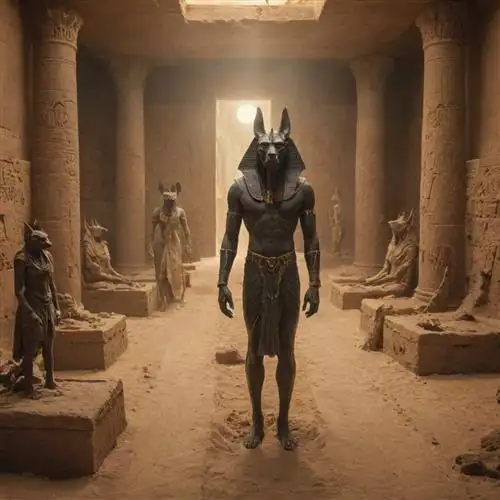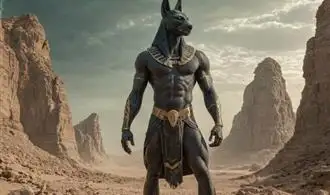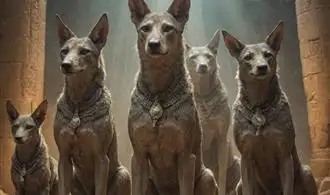
The Origins of Anubis
Anubis, the ancient Egyptian god of the dead, has captivated the imaginations of historians, archaeologists, and enthusiasts for centuries. Tracing the origins of this enigmatic deity reveals a rich tapestry of cultural symbolism, mythological significance, and enduring legacy.
Scholars believe Anubis emerged as a prominent figure during the Early Dynastic period, around 3100-2686 BCE, in the region of Abydos and Cynopolis (modern-day el-Qaw and Kom el-Deir) in Upper Egypt. Initially, Anubis was associated with the jackal or wild dog, a creature often found prowling the deserts and necropolis areas surrounding ancient Egyptian settlements.
The jackal-headed deity was believed to have several pivotal roles in the ancient Egyptian afterlife. As the "Guardian of the Deceased," Anubis was responsible for the embalming process, presiding over the mummification of the dead and ensuring a successful transition to the afterlife. Additionally, Anubis was tasked with weighing the heart of the deceased against the feather of truth, determining whether the individual was worthy of entering the realm of the dead.
The iconography of Anubis further reinforces his importance in ancient Egyptian mythology. Depictions often show the god with the head of a jackal or wild dog, symbolizing his association with the creatures that roamed the desert necropolis. In some cases, Anubis is shown in a fully anthropomorphic form, with a human body and jackal head, emphasizing his dual nature as both a divine and mortal being.
Interestingly, the origins of Anubis's name and the precise meaning behind his iconography have been the subject of ongoing scholarly debate. Some theorize that the name "Anubis" derived from the Greek rendering of the Egyptian "Inpu" or "Anpu," while others suggest it may have roots in the ancient Egyptian word for "royal child" or "to decay."
Anubis Duties and Responsibilities
Anubis, the jackal-headed deity, was one of the most significant figures in ancient Egyptian mythology. As the god of embalming and the afterlife, his duties and responsibilities were crucial in the journey of the deceased through the afterlife. Anubis was responsible for the protection and guidance of the dead, ensuring their safe passage to the next life.
One of Anubis' primary duties was the embalming process. He was believed to have been the inventor of the art of mummification, and as such, he oversaw the entire process of preserving the physical body of the deceased. Anubis would carefully prepare the body, removing the internal organs and treating the skin with various resins and oils to prevent decomposition. This meticulous process was essential in ensuring the deceased could successfully navigate the afterlife.
Another important responsibility of Anubis was the weighing of the heart ceremony, a critical step in the judgment of the dead. During this ritual, the heart of the deceased was weighed against the feather of truth, representing the moral and ethical deeds of the individual. Anubis would oversee this process, ensuring the accurate and impartial judgment of the soul.
Anubis was also tasked with guiding the deceased through the underworld, known as the Duat. He would accompany the soul on its journey, protecting it from the various dangers and obstacles that lay in its path. Anubis would serve as a mediator between the living and the dead, helping the deceased navigate the complex and often treacherous afterlife.
In addition to his duties in the afterlife, Anubis was also revered as a patron of cemeteries and gravesites. He was responsible for the protection and safeguarding of the dead, ensuring that their resting places were secure and undisturbed. Anubis was believed to have the power to ward off grave robbers and other threats to the deceased.
Anubis Iconography and Symbolism
Anubis, the Egyptian god of the dead, is one of the most iconic and recognizable deities of ancient Egyptian mythology. His distinctive jackal-headed appearance has become a powerful symbol of the funerary rituals and beliefs that were central to Egyptian civilization. Delving deeper into the iconography and symbolism of Anubis reveals the profound significance this deity held in the afterlife journey of the ancient Egyptians.
The jackal-headed form of Anubis is believed to have been inspired by the wild canine species native to the Egyptian desert, known for their scavenging behavior around burial sites. This association with the jackal not only reinforced Anubis' role as the guardian of the dead but also symbolized his ability to navigate the liminal spaces between the mortal and divine realms. The dark, sleek fur and sharp features of the jackal were seen as embodying the duality of death and rebirth, making Anubis a pivotal figure in the Egyptian conception of the afterlife.
Anubis' iconography is further enriched by the various objects and symbols he is often depicted holding or wearing. The god is frequently shown holding the was scepter, a symbol of power and authority, and the ankh, the hieroglyphic sign for "life." These attributes underscored Anubis' role as the gatekeeper and guide of the deceased, responsible for ensuring a successful transition into the afterlife. Additionally, Anubis is sometimes depicted wearing the atef crown, a tall headdress associated with the gods of the dead, further reinforcing his status and responsibilities within the Egyptian funerary cult.
The color black, which was associated with the fertile soil of the Nile River and the process of rebirth, was also a significant element in Anubis' iconography. The god's black skin or fur was seen as a symbolic representation of this regenerative power, linking him to the cyclical nature of death and renewal. This association with the color black, coupled with his jackal-headed form, cemented Anubis' position as a central figure in the Egyptian conception of the afterlife and the rituals surrounding death and mummification.
Anubis in Egyptian Mythology
Anubis, the jackal-headed god of ancient Egyptian mythology, played a pivotal role in the beliefs and rituals of the ancient civilization. As the god of mummification and the afterlife, Anubis held a sacred and revered position within the pantheon of Egyptian deities. His presence was ubiquitous, from the intricate funerary rites to the guidance of the dead through the treacherous journey to the afterlife.
In Egyptian mythology, Anubis was closely associated with the process of mummification, a practice that was essential for the preservation of the deceased's physical form. As the patron of this meticulous art, Anubis was responsible for overseeing the embalming process, ensuring that the body was properly prepared for its eternal rest. This role granted Anubis a unique position of importance, as the well-being of the deceased in the afterlife was largely dependent on the quality of the mummification.
Furthermore, Anubis was believed to be the guide of the dead, leading the souls of the departed through the perilous journey to the afterlife. This journey was fraught with challenges, both physical and spiritual, and Anubis was tasked with ensuring the safe passage of the deceased. In this capacity, Anubis was often depicted standing guard at the entrance to the underworld, ready to assist the dead in their transition to the next life.
Interestingly, Anubis was also closely associated with the weighing of the heart ceremony, a critical component of the ancient Egyptian afterlife beliefs. This ritual, in which the deceased's heart was weighed against the feather of truth, determined the individual's worthiness to enter the afterlife. As the overseer of this process, Anubis played a crucial role in the judgment of the dead, ensuring that only the righteous were granted access to the eternal realm.
The Worship of Anubis
Anubis, the jackal-headed god, held a significant role in ancient Egyptian religion and was one of the most revered deities in the pantheon. His worship was deeply rooted in the embalming and burial practices of the Egyptians, as he was responsible for guiding the dead through the afterlife and overseeing the mummification process.
The cult of Anubis was centered in the city of Cynopolis, located in the Nile Delta region. This city, named after the Greek word for "jackal," was the primary site of Anubis' worship and the location of his most important temple. Pilgrims from across Egypt would journey to Cynopolis to make offerings and seek the god's favor in the afterlife.
Anubis' role as the god of embalming and the dead was closely tied to the belief that he had discovered the process of mummification. According to tradition, Anubis was responsible for embalming the body of Osiris, the god of the underworld, after his murder by Set. This act established Anubis as the patron of embalmers and the protector of the dead.
During the mummification process, the priests who performed the rituals would wear masks depicting the jackal-headed Anubis. This symbolic identification with the deity was believed to imbue the priests with the god's power and authority, ensuring the proper preparation of the deceased for the afterlife.
Anubis was also closely associated with the weighing of the heart ceremony, a critical step in the journey to the afterlife. In this ritual, the heart of the deceased was weighed against the feather of truth, and if it was found to be pure, the individual was granted passage to the realm of the dead. Anubis was responsible for overseeing this process, ensuring the fairness and accuracy of the judgement.
The worship of Anubis was not limited to the elite classes; his cult was popular among all levels of Egyptian society. Ordinary citizens would make offerings and seek the god's protection for their loved ones, believing that he would ensure their safe passage to the afterlife.















